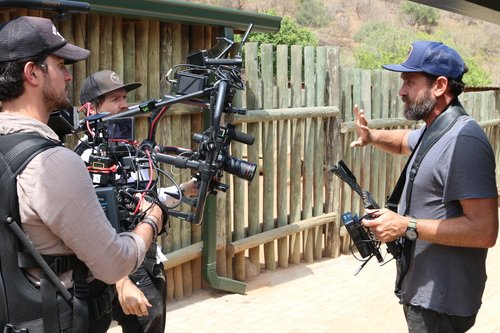Written and directed by Leila Djansi, 40 and Single is an UMC (Urban Movie Channel) television series that tells the story of a bisexual, mixed race, single bridal fashion designer as she maneuvers life and business in post-colonial Africa. It recently won the Audience Award at The LA Film Festival for Episodic Pilot and was shot by cinematographer Pietro Villani with the EVA1 cinema camera.
According to Villani, the biggest challenge in shooting 40 and Single was shooting in Ghana, which has no production infrastructure. Because of this, he needed a camera that was compact and lightweight for run-and-gun shooting, could capture in low-light environments, and had wide dynamic range for uncontrolled lighting environments. “You sacrifice having your usual gear and crew in trade for a beautiful country and their hard working crew,” says Villani. “We had a fair amount of night exteriors and I needed a camera that could use the existing street light as a base. Condors were not in the budget and they don’t really use them in Ghana, so a camera that could handle that amount of low light was necessary. In the daylight shots, I had a cast with mixed skin tones – dark, medium, and light – to deal with in an uncontrolled environment with small HMI heads.”
Due to the show’s modest budget, Villani knew he had to be creative in his approach to the visuals. He and Djansi had previously shot a feature film in Ghana and wanted to create a completely different look. “I did tests on dark skin people here in the U.S. and tried different looks,” explains Villani. “For this movie, we just touched on references in the film and art world, but we tried to approach it as if it was the first time anyone had shot in Ghana, or Africa.”
With the EVA1, Villani shot in UHD (3840×2160) at 23.98-fps in 10-bit 422 LongGOP 150. (The ALL-I 400Mbps codec had not been released at the time of shooting.) “I was shooting mixed skin colors so I need the most range I could get,” reveals Villani. “I like the Panasonic V709 LUT because it’s a little aggressive, which gives me safety since the blacks are very crushed and the whites are pushed. I did many tests back in LA with my D.I.T., Dino Dumandan. I would always look at the V-Log before we shot and gauged it there.”

For many of the night exteriors, Villani shot under street lights and added his own small fixtures to accent the feel of the sodium vapor lamps in Ghana. “I set the ISO at 2500 base and then dialed down to 1600,” he says. “There was no noise. It is hard to get used to cranking up the camera and shooting that way. Old habits die hard and new ground is sometimes scary, so you could say I played it safe.” For lenses, Villani went with Canon Cinema EOS primes. According to Villani, the Canon lenses felt right with the EVA1 and had the speed he needed for night exteriors.
One of the most difficult scenes was shot in a bridal shop, which had tinted windows that were an ND 12 and were similar to ½ CTO. “I had two 4K HMI pars that I would blast through windows, but I had to gel them to 1/2 CTB to combat the tint,” says Villani. “I didn’t get the push I wanted so I had to get creative with exposure and placement of interior heads. Because of this, there wasn’t as much ambient light in the room so I had to place small lights inside to bring up the ambient and help the windows wrap. I have to say that watching the footage you would never know the issues I had to deal with. People will watch the scenes and say, “Oh, that daylight interior with plenty of windows must have been easy to shoot.”

40 and Single was posted at Simerly Post Productions. Villani set his looks by grading still images on his own computer and would send them to his colorist for reference. “I like sending stills that I corrected because I feel it gets them thinking about the grade before I arrive,” explains Villani. “The way this show was posted, I could spend some time in the suite coloring like a feature, but not to the full extent.
“The EVA1 really lived up to and surpassed what I thought it would be capable of doing,” continues Villani. “Great latitude, image, workflow, and capabilities. As Dino said many times, ‘I can’t believe how great this camera is.’ I’m still floored at seeing the footage that came out of this little camera.”
Credit: Neil Matsumoto, Panasonic
For more info on the Panasonic EVA1, visit http://bit.ly/PANASONICEVA1AU
For more information on Pietro Villani, visit www.pietrovillani.com.




